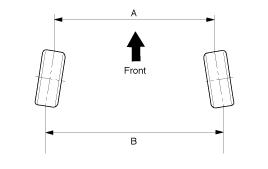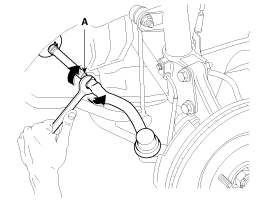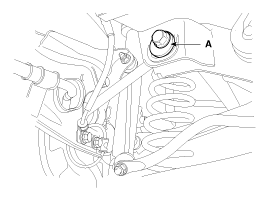Kia Optima Hybrid: Tires/Wheels / Alignment Repair procedures
| Front wheel alignment |
When using a commercially available computerized wheel
alignment equipment to inspect the front wheel alignment, always
position the vehicle on a level surface with the front wheels facing
straight ahead.
Prior to inspection, make sure that the front suspension and
steering system are in normal operating condition and that the tires are
inflated to the specified pressure. |

B - A > 0: Toe in (+)
B - A < 0: Toe out (-) |
| 1. |
Loosen the tie rod end lock nut. |
| 2. |
Remove the bellows clip to prevent the bellows from being twisted. |
| 3. |
Adjust the toe by screwing or unscrewing the tie rod. Toe
adjustment should be made by turning the right and left tie rods by the
same amount.
|
| 4. |
When completing the toe adjustment, install the bellows clip and tighten the tie rod end lock nut to specified torque.
|
| 5. |
Compensate the steering angle sensor after adjusting the wheel alignment.
(Refer to Steering System - "Steering Column-Shaft") |
Camber angle: -0.5° ± 0.5° |
Caster angle : 4.34° ± 0.5° |
| Rear wheel alignment |
When using a commercially available computerized wheel
alignment equipment to inspect the rear wheel alignment, always position
the vehicle on a level surface.
Prior to inspection, make sure that the rear suspension
system is in normal operating condition and that the tires are inflated
to the specified pressure. |

B - A > 0: Toe in (+)
B - A < 0: Toe out (-) |
| 1. |
Loosen the nut holding the assist arm cam bolt (A). |
| 2. |
Adjust rear toe by turning the rear assist arm cam bolt (A)
clockwise or counter clockwise. Toe adjustment should be made by turning
the right and left cam bolt by the same amount.
|
| 3. |
When completing the toe adjustment, tighten the nut to specified torque.
|
Camber: -1.0° ± 0.5° |
 Wheel Repair procedures
Wheel Repair procedures
Hub nut tightening sequence Tighten the hub nuts as follows. Tightening torque: 88.3 ~ 107.9N.m (9.0 ~ 11.0kgf.m, 65.1 ~ 79.6lb-ft) When using an impact gun, final tightening torque should ...
Other information:
Kia Optima Hybrid (TF HEV) 2016-2020 Service Manual: Side Body Body Repair
Side Body A Front side member tooling hole (O20)Fender apron tooling hole (O10)Front door upper hinge mounting hole (O13)Front door lower hinge mounting hole (O13)Fender panel mounting hole (O6.6)Rear door upper hinge mounting hole (O13)Rear door lower hinge mounting hole (O13)Rear door switch mounting ...
Kia Optima Hybrid (TF HEV) 2016-2020 Service Manual: Components and Components Location
Component Location [Vehicle Installation component] 1. Automatic transaxle2. Transaxle control module (TCM)3. Shift lever4. Data Link Connector (DLC) [Transaxle Installation component] 1. Input speed sensor2. Output speed sensor3. Solenoid valve connector4. Oil temperature sensor5. Valve body assembly6. ...




